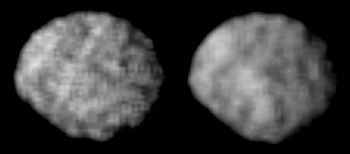Larissa (moon) facts for kids
 Two views of Larissa by Voyager 2 |
|
| Discovery | |
|---|---|
| Discovered by | Harold J. Reitsema, William B. Hubbard, Larry A. Lebofsky, and David J. Tholen |
| Discovered on | May 24, 1981 |
| Orbital characteristics | |
| Epoch 18 August 1989 | |
| Semi-major axis | 73 548 ± 1 km |
| Eccentricity | 0.001393 ± 0.00008 |
| Orbital period | 0.55465332 ± 0.00000001 d |
| Inclination | 0.251 ± 0.009° (to Neptune equator) 0.205° (to local Laplace plane) |
| Is a moon of | Neptune |
| Physical characteristics | |
| Dimensions | 216×204×164 km (± ~10 km) |
| Mass | ~4.2×1018 kg (estimate) |
| Mean density | ~1.2 g/cm3 (estimate) |
| Rotation period | assumed synchronous |
| Axial tilt | ~zero presumably |
| Albedo (geometric) | 0.09 |
| Surface temp. | ~51 K mean (estimate) |
| Atmosphere | none |
Larissa, also known as Neptune VII, is one of the many moons that orbit the giant planet Neptune. It is the fifth moon closest to Neptune. Its name comes from Larissa, a character from Greek mythology who was a lover of Poseidon, the Greek god of the sea (who is similar to the Roman god Neptune).
Discovering Larissa
Larissa was first spotted on May 24, 1981. It was found by a team of scientists: Harold J. Reitsema, William B. Hubbard, Larry A. Lebofsky, and David J. Tholen. They used a special method called stellar occultation. This means they watched as the moon passed in front of a distant star, briefly blocking its light. This helped them figure out the moon was there.
At first, it was given the temporary name S/1981 N 1. Later, in 1989, the Voyager 2 spacecraft flew past Neptune. It confirmed that Larissa was indeed a moon and the only object in its orbit. After this, it received another name, S/1989 N 2.
What Larissa is Like
Larissa is not perfectly round like Earth's Moon. It has an irregular shape, measuring about 216 by 204 by 164 kilometers. This makes it look more like a potato than a ball.
The surface of Larissa is covered in many craters. These craters are likely from impacts with space rocks over billions of years. Scientists haven't found any signs that its surface has changed much over time, meaning there isn't any active geology like volcanoes or shifting land.
Larissa orbits Neptune very closely. It takes about half an Earth day (0.55 days) to complete one trip around Neptune. It is also thought to be tidally locked to Neptune. This means that the same side of Larissa always faces Neptune, just like our Moon always shows the same face to Earth.
Not much else is known about this distant moon, but it's an interesting part of Neptune's family of satellites.
Images for kids
See also
 In Spanish: Larisa (satélite) para niños
In Spanish: Larisa (satélite) para niños



